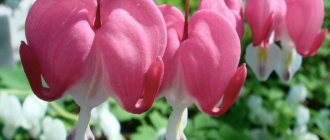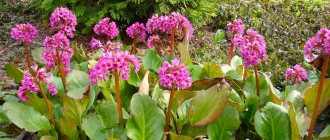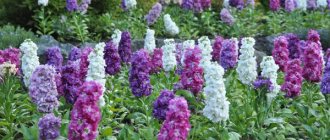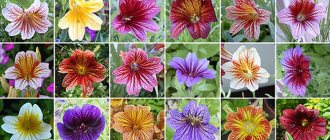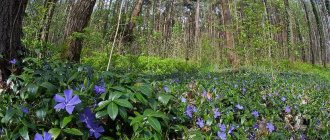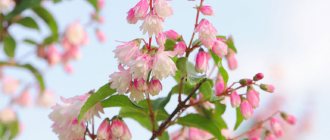From summer to autumn, buddleia attracts swarms of colorful butterflies to the garden. This shrub is doubly attractive, because its flowers are an amazing sight, and surrounded by delicate insects it looks simply fabulous. Although the plant has a somewhat exotic appearance, it grows well in temperate climates. Find out how buddleia is grown - planting and care in open ground, growing from seeds, propagating shrubs.
Description
Deciduous shrub, Norichinaceae family. The plant is named after the biologist who found it. The homeland is the tropics, so buddleia prefers warmth.
Bloom
From mid-summer to early autumn. With proper care it is very lush.
Flowers
Collected in clusters up to 45 cm long, of various colors, they have a pleasant aroma that attracts bees and butterflies. Because of this feature, it has another name “moth tree”.
Trunk
The buddleia bush is branched, with drooping shoots. Up to 3 m in height.
Roots
They are not located deep, growing close to the surface.
Benefits of the bush
The Buddleia David shrub has a huge number of advantages rather than disadvantages. These include:
- unpretentiousness;
- beautiful appearance;
- long flowering period;
- fast growth.
The plant has a fairly long flowering period. Upon completion, you can observe the appearance of boxes with Buddleia David seeds.
Buddleia species
The bush of the plant can be varied; many species and varieties have been bred, ranging from herbaceous flowers to trees up to 5 m in height.
Let's look at them:
- White-flowered. The inflorescences are snow-white and cone-shaped.
- Snezhnaya. Rarely distributed, originally from Japan, inflorescences 15 cm, pinkish, leaf blades with villi.
- David. Tall, with dark leaves. They have pubescence. The inflorescences are large, up to 35 cm. Blooms for 1.5 months.
- Globular. The original inflorescences form balls, hence the name, yellow in color, thermophilic.
- Japanese. Fast growing with crimson flowers.
We recommend reading:
- Flowers in August: photos and description
- Garden flowers that bloom in July: photos and names
- Lilac - varieties, types, selection rules, planting nuances, cultivation secrets and care (105 photos and videos)
Cost of budley
Depending on the type, the cost of plant seedlings varies from 450 rubles. and up to several thousand. If we talk about seeds, they are not so expensive: 1 package can be purchased for 25-75 rubles. However, if the seedlings are purchased from a nursery, they are healthy and will begin to grow quickly after planting. In just a few years you will be able to admire the magnificent blooms of these southern beauties.
With seeds everything is more complicated. They will have to be grown until at least 2 years of age, and only then will it be time to plant the grown sprouts in the garden. Planting and growing buddleia in the Moscow region requires careful adherence to the rules of agricultural technology, care procedures and the choice of a frost-resistant plant variety. In order for the planted bush to develop normally, you need to choose a well-lit place and suitable soil, and so that the flowering bush does not freeze out, you need to cover it for the winter. This will allow it to begin development faster next year and delight its owners with flowering longer.
Buddleia varieties
The variety of varieties is amazing; they are represented by flowers of various shades from white to purple:
- White bouquet. Snow-white flowers are collected in large clusters. Blooms from mid-summer to autumn.
- Nano blue. Slender crown, up to 1.5 m, purple flowers, gray leaves on the reverse side.
- Royal ed. Purple flowers, long inflorescences.
- Flower Power. 2m, spreading shrub, blooms 45 days, frost-resistant.
- Pink do it. Medium-sized bush, pink flowers with a silver tint, native to China. They have a great smell.
Reproduction
Buddleia can be propagated both by seeds and cuttings (Figure 3), which are formed at the end of the flowering period. Since each method has its own characteristics, it makes sense to dwell on the various methods of reproduction in more detail.
Growing from seeds
Propagation of buddleia by seeds is a rather labor-intensive process, and therefore is most often used by breeders to develop new varieties.
At the beginning of spring, planting material is sown in peat cups, covered with glass or polyethylene and sent to a warm place for germination for 2-3 weeks. The sprouts are ventilated and the soil is moistened once every 3 days. The strengthened seedlings are transferred to a permanent place in open ground.
Propagation of buddleia by cuttings
The easiest way for Buddleia to propagate is by cuttings. To do this, after the end of flowering, it is necessary to cut off several young shoots with 3-4 buds, remove the lower leaves from them and treat them with a growth stimulator.
Figure 3. Stages of propagation of shrubs by cuttings
Prepared cuttings are planted in loose soil, watered and covered until rooting. Even in winter, under cover, the cuttings are not afraid of frost, so in the spring they begin a period of active growth.
Landing conditions
It is better to plant buddleia with a closed root system, which is purchased at gardening centers. When purchasing from it, they inspect it to ensure there are no pests or damaged parts.
Planted in open sunny places, without stagnant moisture.
Between plants, especially different varieties, leave a distance of about 1-2 m.
The soil should be loose and allow water and air to pass through well. Make a hole with a diameter of 50 cm, add fertilizers, ash, and humus.
Transfer the buddleia from the pot, trying not to disturb the earthen lump. The root collar is not buried. The soil is compacted and then watered.
Popular questions and answers
We asked agronomist Oleg Ispolatov - he answered the most popular questions from summer residents.
How to choose buddleia seedlings?
The best option is seedlings in containers, because unlike bare-root seedlings, they have a healthy root system and a high survival rate. And you can plant them almost all season long, without fear of frost or drying out of the root system.
What to do with buddleia in the fall?
Buddleia Davida has a very long growing season; its shoots continue to develop until the first frost. In winter, they usually freeze over. Therefore, the bushes are trimmed and covered. It is advisable to transplant shrubs of the first year of cultivation into containers in September so that they can be stored in a frost-free, but not heated, bright room.
What to do with buddleia in winter?
In winter, the plantings are well covered with snow - the higher the snowdrift, the better the buddleia will be preserved. Plants brought indoors are watered periodically.
What to do with buddleia in spring?
The main task is to remove the shelter in a timely manner, prune and fertilize. Spring is the best time to plant buddleia. It is important to follow the rule: plant without deepening the root collar, and at a distance of at least 1 m from each other.
Is it possible to grow buddleia in the Moscow region?
Can.
Moreover, buddleias are grown even in the Urals and Siberia. It all depends on the variety, adherence to agricultural technology and proper maintenance in winter. Sources
- Aksenov E., Aksenova N. Ornamental gardening for amateurs and professionals. Trees and shrubs // M.: AST-Press, 2001
- Buddleja // The Plant List https://www.theplantlist.org/1.1/browse/A/Scrophulariaceae/Buddleja/
- State catalog of pesticides and agrochemicals approved for use on the territory of the Russian Federation as of July 6, 2022 // Ministry of Agriculture of the Russian Federation https://mcx.gov.ru/ministry/departments/departament-rastenievodstva-mekhanizatsii-khimizatsii- i-zashchity-rasteniy/industry-information/info-gosudarstvennaya-usluga-po-gosudarstvennoy-registratsii-pestitsidov-i-agrokhimikatov/
Buddleia care
Planting and caring for a plant is a pleasure. Even a young gardener can cope with buddleia. Steps needed to take care of your plant:
- Regular watering both at the root and from a hose with warm water. Water consumption is about 10 liters per bush. If it is raining outside, the procedure is not carried out.
- Fertilizing with constant alternation of organic and mineral fertilizers, for abundant flowering, potassium and phosphorus.
- Regular pruning prolongs the formation of buds.
- Inspect the buddleia at least once every few days. If unsightly spots appear, the leaves turn yellow, this is a sign of disease or insect attack.
The buddleia flower pleases its skillful owners with long-lasting flowering, decorating the garden plot for a long time.
Trimming
Caring for autumn lilac bushes does not imply constant grooming of the bush with pruning shears. But pruning in early spring only brings benefits - this way the bush retains its compact shape and flowering density. Before performing the procedure, be sure to treat the pruning shears and hacksaw with disinfectants and sharpen them. Perform pruning in compliance with the following rules:
- You can shorten the branches of the plant only after the end of frost - usually the beginning of March.
- The first in line for removal are diseased, frost-damaged, dead and weakened shoots.
- It is better to cut healthy stems of bushes to one level; to maintain their shape, the normal length is 60 cm.
Buddleia varieties that bloom in the summer season are cut short - old faded shoots are completely removed. It is not recommended to use the classic form of pruning shears - there is a tool for pruning and shaping shrubs with telescopic handles. When using such scissors, there is less risk of damaging those branches that need to be left intact to preserve their decorative appearance.
Reference!
The evergreen shrub variety “Colivillei” can bloom on branches left over from last year. This type of buddleia is not completely pruned - the branches on which there were inflorescences can be slightly shortened. In April, the longest branches are partially cut back so that the bush does not lose its attractiveness due to its height.
Examples of use in landscape design
Typically, autumn lilacs are grown as a solitaire surrounded by low perennial flowers. Buddleia is great for forming a hedge or as a camouflage for an unsightly part of a plot.
Good neighbors for Buddleia will be:
- asters;
- lavender;
- lefty;
- sage.
Features of cultivation
Budleya almost never gets sick and is rarely affected by pests. Gardeners may only be concerned about 2 problems:
- Spider mite. The pest settles on shrubs during severe drought. Shoots on which you find small cobwebs should be cut off, and healthy bushes should be treated with an insecticide solution.
- Gray rot. This is a fungal disease that can appear on buddleia inflorescences during the rainy season. In this case, the flowers are covered with a layer of gray “flour”. The affected parts of the plant must be removed and burned, and to prevent the infection from spreading to healthy shoots, the bush is treated with a 0.2% solution of Fundazol or another fungicidal preparation.
Budleya is almost the same lilac. It grows in one place for a long time and requires minimal care. This shrub is especially well suited for growing in the southern regions of the country. Provided it is covered for the winter, it can be planted in mid-latitudes. But in the north, this heat-loving plant is unlikely to take root, so it is very rarely found in the Siberian and Ural gardens of Russia.
Beneficial features
Buddleia is actively used in traditional medicine recipes . Thus, residents of Madagascar use the plant for exacerbations of bronchitis and as a pain reliever.
In China, decoctions and infusions of autumn lilac bark are used. In South America, buddleia is used for rheumatic pain and digestive disorders.
When conducting research, it was revealed that the plant contains the following beneficial substances:
- saponins;
- diterpenes;
- flavonoids;
- phenylpropanoid glycosides and others.
Such a rich chemical composition makes buddleia a valuable medicinal raw material.
Buddleia is not only a very attractive shrub with lush decorative flowering, but also an excellent honey plant and practically a home pharmacy, growing well in a summer cottage.
Diseases, pests
Autumn lilac has high immunity and practically does not get sick. Seedling sprouts are sometimes affected by blackleg, but regular treatments with Fitosporin help solve this problem.
Pests that pose a threat to buddleia include:
- aphid;
- spider mite
Insecticides will help solve the problem and restore the health of the bush.
Preparing for cold weather
Since buddleya is not a frost-resistant plant and does not tolerate strong drops in temperature, its preparation for winter cold is a special point in the care process.
In order for the shrub to safely survive the next winter, the following measures must be taken:
- Insulation of the root system.
- If local climatic conditions are extremely harsh, then the entire bush must be insulated. To do this, it will need to be trimmed so that only stems no more than 15-20 cm high remain above the ground, which will allow you to simultaneously insulate both the outer part of the buddleia and its roots.
- The top of the bush is covered with a box or frame made of wood, after which roofing material is laid to retain heat inside.
- It is imperative to provide access to fresh air inside, otherwise the buddleia will have time to dry out over the winter.
3.Varieties:
3.1.Buddleja Davidii or changeable - Buddleja Davidii
A beautifully flowering multi-stemmed shrub up to 5 m high, it was named after the priest Armand David, who first wrote down a description of the plants. The plant develops quickly, has opposite, simple, oblong-lanceolate leaves up to 20 cm long. The flowers are small, fragrant, in shades of lilac, purple, white, yellow or pink, collected in large apical racemes.
Most modern varieties are bred on the basis of this particular plant.
3.2. Buddleja Royal Red - Buddleja davidii “Royal Red”
Abundantly branching shrub up to 1.5 m high with narrowly lanceolate green or bluish-green leaves. During the flowering period, the plant forms large fragrant racemes up to 25 cm long with many crimson or burgundy flowers.
3.3.Buddleja Black Knight - Buddleja davidii “Black Knight”
Large flowering deciduous shrubs with a rounded crown up to 3.5 m high. The leaves are green, lanceolate, located opposite. The plant has large apical racemes up to 20 cm long, consisting of a large number of spectacular, fragrant, dark purple, almost black flowers.
3.4. Buddleja Flower Power - Buddleja davidii “Flower Power”
A spectacular flowering plant, the main distinguishing feature of which is large inflorescences - brushes, painted in 2 shades. Unopened buds of this variety have a purple hue, while opening flowers have a pink tint, and once open flowers turn salmon or orange.
3.5. Buddleja “Nanho Blue” - Buddleja davidii “Nanho Blue”
Compact deciduous shrub up to 1.5 m high with gray-green oblong leaves and large clusters up to 25 cm long, consisting of soft lilac or blue flowers. The flowering period is very long, begins in June and continues until mid-autumn.
3.6. Buddleja "Adonis Blue" - Buddleja davidii "Adonis Blue"
Shrubs with bluish-green or gray-green foliage, during the flowering period they form long, narrow racemes with small lavender flowers.
3.7. Buddleja "Empire Blue" - Buddleja davidii "Empire blue"
Relatively compact shrubs up to 2 m high with green narrow-lanceolate opposite leaves and long (up to 25 cm) clusters of dark blue fragrant flowers.
3.8. Buddleja "Harlequin" - Buddleja davidii "Harlequin"
This variety can be safely classified as both a flowering plant and an ornamental foliage plant, because in addition to large flower clusters, it has a rich purple hue and attractive foliage. The green leaf blades along the edges are painted white or cream.
3.9. Buddleia “Ile de France” - Buddleia davidii “Ile de France”
A large deciduous shrub up to 2.5 m high with erect branched shoots, green narrow leaves and long conical racemes of fragrant pink or purple flowers.
3.10.Buddleja "Gulliver" - Buddleja davidii "Gulliver"
"Gulliver" is a compact deciduous shrub up to 1.75 m high with spear-shaped, gray-green leaves. A distinctive feature of the variety is its very large inflorescences - apical panicles up to 30 cm long with lilac fragrant flowers.
3.11. Weyer's Buddleia - Buddleia x weyeriana
Beautiful flowering shrubs bred during the First World War by the military man, Major William van de Weyerer. A distinctive feature of the plants is the golden-orange or yellow hue of the flowers. Weyer's buddleia often forms not the usual brushes, but spherical inflorescences or brushes, which contain several such rounded formations at once.
3.12. Buddleia “Sungold” - Buddleia weyeriana “Sungold”
A charming flowering shrub with grayish-green lanceolate leaves and golden clusters of small fragrant flowers.
3.13. Buddleja alternifolia
Deciduous multi-stemmed shrub with thin, often drooping shoots. The leaves are small, lanceolate, gray-green. During the flowering period, the plant is abundantly covered with long (up to 50 cm), hanging inflorescences of lilac flowers and its appearance resembles a weeping willow.
You might also be interested in:
Hydrangea
Rhododendron
Juniper
Hellebore
Top dressing
Feeding 1 (in spring, when buds appear): nitrogen fertilizers for non-fruiting bushes, you can use “Urea” PETER PEAT from the MINERAL line.
Feeding 2 (early July shoot growth phase and first ten days of September), options:
- potassium-phosphorus fertilizers for non-fruit-bearing bushes + wood ash 200-300 g/sq.m + humus 3 buckets per bush;
- complex mineral fertilizer PETER PEAT NPK 15-15-15" of the MINERAL line.
Feeding 3 and subsequent ones (2 weeks after feeding 1 and then with the same step):
- liquid humic fertilizer PETER PEAT “Living force: for flower crops”;
- mullein with water (1:12).
After flowering
Caring for shrubs after flowering is not too difficult, but requires following certain recommendations.
Collecting seeds
If you want to collect seeds yourself for growing seedlings, then the optimal time for this procedure is the end of September - the first half of October.
When collecting buddleia seeds, you need to focus on size: seeds that are too small will most likely not germinate.
Wintering
Although many varieties of buddleia have high frost resistance , they need to be covered for the winter in the first three years.
After sanitary autumn pruning, when the plant has gone into hibernation, it is covered with non-woven material or a wooden box is placed on top of the bush and covered with humus.
